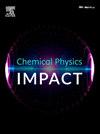Repurposing antiviral drugs targeting the PARP-1 and HER2 pathways with multifaceted impacts through integrated network analysis and molecular mechanics
IF 3.8
Q2 CHEMISTRY, PHYSICAL
引用次数: 0
Abstract
This study investigates the anticancer potential of existing anti-viral drugs using a comprehensive suite of computational methods. A dataset of 76 antiviral drugs was prepared and optimized for analysis. Through the application of network pharmacology, gene ontology, and Kyoto Encyclopedia of Genes and Genomes (KEGG) pathway enrichment analyses, this study identified Human Epidermal Growth Factor Receptor 2 (HER2) and Poly [ADP ribose] polymerase 1(PARP-1) as key targets involved in the molecular pathways associated with breast cancer. Protein sequence alignment further revealed conserved and semi-conserved amino acid regions, including residues such as Arginine (ARG), Aspartic acid (ASP), and Phenylalanine (PHE), offering valuable insights into the structural characteristics of the target proteins. Molecular docking studies were performed to evaluate drug-receptor interactions, leading to the selection of promising candidates: Fostemsavir, Efavirenz, Doravirine, and Didanosine for HER2, and Efavirenz, Lopinavir, Fostemsavir, and Elvitegravir for PARP-1. The binding affinities observed were -7.92 Kcal/mol for HER2 and -8.08 Kcal/mol for PARP-1 for Efavirenz, and -8.17 Kcal/mol for HER2 and -7.91 Kcal/mol for PARP-1 for Fostemsavir. Subsequent molecular dynamics simulations, conducted over 200 ns, assessed the stability of these drug-protein complexes. Binding free energy was calculated using Molecular Mechanics/Generalized Born Surface Area (MM-GBSA) methods, reinforcing the stability and efficacy of the selected compounds followed by entropy calculation using Normal mode analysis done for Efavirenz complexes. Results of this study demonstrated that Efavirenz exhibits strong binding and notable potential as HER2 and PARP-1 inhibitors. Efavirenz demonstrated effectiveness against both targets, emphasizing its potential and showcasing drug repurposing as a promising strategy in cancer therapy development.

通过综合网络分析和分子力学,重新利用抗病毒药物靶向PARP-1和HER2通路,具有多方面的影响
本研究使用一套全面的计算方法来研究现有抗病毒药物的抗癌潜力。建立了76种抗病毒药物的数据集,并对其进行了优化。本研究通过网络药理学、基因本体论、京都基因与基因组百科全书(KEGG)通路富集分析,确定了人表皮生长因子受体2 (HER2)和聚[ADP核糖]聚合酶1(PARP-1)是参与乳腺癌相关分子通路的关键靶点。蛋白质序列比对进一步揭示了保守和半保守的氨基酸区域,包括精氨酸(ARG)、天冬氨酸(ASP)和苯丙氨酸(PHE)等残基,为了解目标蛋白的结构特征提供了有价值的见解。进行分子对接研究以评估药物受体相互作用,从而选择有希望的候选药物:用于HER2的Fostemsavir、Efavirenz、Doravirine和Didanosine,以及用于PARP-1的Efavirenz、Lopinavir、Fostemsavir和Elvitegravir。Efavirenz与HER2和PARP-1的结合亲和力分别为-7.92 Kcal/mol和-8.08 Kcal/mol, Fostemsavir与HER2和PARP-1的结合亲和力分别为-8.17 Kcal/mol和-7.91 Kcal/mol。随后的分子动力学模拟在200 ns内进行,评估了这些药物-蛋白质复合物的稳定性。结合自由能采用分子力学/广义出生表面积(MM-GBSA)方法计算,增强了所选化合物的稳定性和有效性,然后使用依非韦伦配合物的正态模式分析计算熵。本研究结果表明Efavirenz具有很强的结合性和作为HER2和PARP-1抑制剂的显著潜力。Efavirenz证明了对这两个靶点的有效性,强调了它的潜力,并展示了药物再利用作为一种有前途的癌症治疗发展策略。
本文章由计算机程序翻译,如有差异,请以英文原文为准。
求助全文
约1分钟内获得全文
求助全文
来源期刊

Chemical Physics Impact
Materials Science-Materials Science (miscellaneous)
CiteScore
2.60
自引率
0.00%
发文量
65
审稿时长
46 days
 求助内容:
求助内容: 应助结果提醒方式:
应助结果提醒方式:


